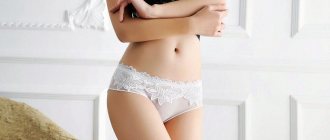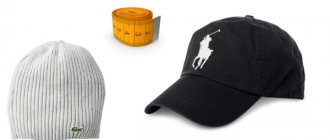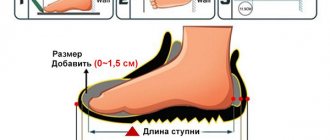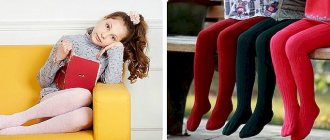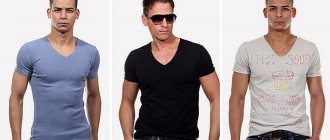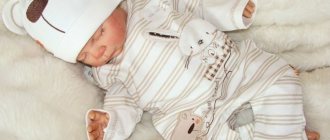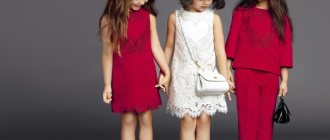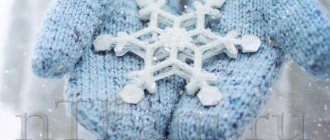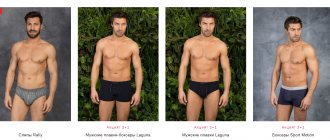Home / Dimensions
Back
Published: 08/16/2021
Reading time: 2 min
0
3
Socks are an essential element of a child’s wardrobe, starting from newborn age. Therefore, the most stringent requirements are imposed on products. The main condition for comfortable wearing is the correct size of children's socks. There are several ways to define it.
- 1 Accurate way to measure your foot
- 2 Size charts 2.1 By foot length
- 2.2 By age
- 2.3 Compliance
How to determine the size of children's socks
In order to understand what size socks your child needs, you need to measure his foot. There is a fairly simple and effective method that will be useful to you.
- Take a sheet of white paper, notebook or landscape (the main thing is that it is larger than the baby’s foot)
- The child must stand on the sheet
- Draw an outline around his foot
- On paper, mark the center point of the heel contour
- The second point is placed on the outline of the thumb
- Measure the distance between the points (with a ruler, metric tape or tape measure)
The resulting length of the segment, in centimeters, will then determine the size of the foot.
Accurate way to measure your foot
To get the most reliable data, it is best to take measurements from both legs.
To do this, you need to put the child on paper to trace the outline of first one foot, then the other. If the baby is not standing yet, then attach the leg to the sheet and outline it. Then measure the segment from the most protruding toe to the border of the heel. Compare both results, select the largest and round it up to the next value.
Advice! When choosing, in addition to foot measurements, it is necessary to take into account the child’s weight. If your body weight exceeds the age norm, then you need a product one or two numbers larger.
Size designations for children's socks
Manufacturers of socks, even within the same country, may have different sizes of socks for children; it is worth remembering the most typical tables that are found. For example, some hosiery manufacturing companies in Russia mark children's socks with even numbers, omitting odd ones, while others use whole numbers sequentially. At the same time, the products have foreign (10.5) or letter (S, M, L) designations.
If the age is indicated on the socks, this indicates the elasticity of the material of the product and its ability to adapt to 3 adjacent sizes. When choosing socks labeled by age, it is worth considering that at maximum stretch the fabric will become thinner, which can create pressure on the toes and the instep if it is high. An average division of products by age group will be useful if knee socks are purchased as a gift for the children of friends whose parameters are not possible to find out.
| Age | Foot length in cm | Russian size |
| 0-1 month | up to 6.4 | 10 |
| 0-1.5 months | 6,5-7,4 | 10 |
| 0-3 months | 7,5-8,4 | 10 |
| 1.5-3 months. | 8,5-9,4 | 10 |
| 3-6 months | 9,5-10,4 | 10 |
| 6-9 months | 10,5-11,4 | 12 |
| 9-12 months | 11,5-12,4 | 12 |
| 1-1.5 years | 12,5-13,4 | 14 |
| 1.5-2 years | 13,5-14,4 | 14 |
| 2-3 years | 14,5-15,4 | 16 |
| 3-4 years | 15,5-16,5 | 16 |
| 4-5 years | 16,5-17,4 | 18 |
| 5-6 years | 17,5-18,4 | 18 |
| 6-7 years | 18,5-19,4 | 20 |
| 7-8 years | 19,5-20,4 | 20 |
| 8-9 years | 20,5-21,4 | 22 |
| 9-10 years | 21,5-22,4 | 22 |
Sock sizes in Russia are designated by numbers from 6 (sometimes sock sizes for newborns are designated 0+) to 22, American products are labeled 2-12, and European ones are labeled 16-29. Asian sock sizes are often designated by letters and are always “small” compared to European ones. In order not to get confused by regional differences in product designations, it is useful to have comparative tables on hand, in which the sizes of children's socks from different manufacturing countries are indicated in parallel in one line.
| Age | Foot length, cm | European size | US size |
| 0-3 ms. | 9.5 | 16-17 | 0-2 |
| 0-6 months | 10.5 | 17-18 | 2,5-3,5 |
| 6-12 months | 11.7 | 19 | 4-4,5 |
| 12-18 months | 12.5 | 20 | 5-5,5 |
| 18-24 months | 13.4 | 21-22 | 6-6,5 |
| 2 years | 14.3 | 23 | 7 |
| 2.5 years | 14.7 | 24 | 7,5-8 |
| 2.5-3 years | 15.2 | 25 | 8-8,5 |
| 3-3.5 years | 16 | 26 | 9-9,5 |
| 4 years | 17.3 | 27 | 10-10,5 |
| 4.5 years | 17.6 | 28 | 11-11,5 |
| 5 years | 18.4 | 29 | 12 |
Labeling of different countries
Different countries have adopted their own designations for sizes of clothing, shoes and socks. Of course, this creates some difficulties, but having certain knowledge and tools, we can easily compare measurement data with correspondence tables. Before purchasing, be sure to read the main markings in order to navigate the size ranges.
Russian manufacturers use age and digital markings for children under one year of age. Markings indicated by numbers usually have a step of 2 points. But there are manufacturers who enter intermediate values, then the step is 1.
European manufacturers use digital markings to mark socks, but they differ from the Russian markings we are already familiar with. For example, a child’s foot length of 16 cm corresponds to the European (EU) 25th. If you see EU markings on the label of socks, be sure to refer to the sizing chart and check the information.
American (US) and English (UK)-made socks have their own digital designations, which can be written as an integer (7) or as two numbers separated by a slash (5.5/6).
Size chart for children's socks by foot size
The length of the foot is the value by which the size of children's socks is determined. Below is the corresponding table.
| Foot length(cm) | Sock size |
| 9,7 | 10 |
| 10,4 – 11,0 | 12 |
| 11,0 – 11,6 | 12 |
| 11,6 – 12,2 | 12 |
| 12,2 – 12,8 | 14 |
| 12,8 – 13,5 | 14 |
| 13,5 – 14,2 | 14 |
| 14,2 – 14,8 | 16 |
| 14,8 – 15,5 | 16 |
| 15,5 – 16,2 | 16 |
| 16,2 – 16,9 | 18 |
| 16,9 – 17,6 | 18 |
| 17,6 – 18,3 | 18 |
| 18,3 – 19,0 | 20 |
| 19,0 – 19,7 | 20 |
| 19,7 – 20,4 | 20 |
| 20,4 – 21,1 | 22 |
| 21,1 – 21,8 | 22 |
| 21,8 – 22,5 | 23 |
Compression jersey Varisan
Varisan compression products are presented in two lines with different dimensional grids:
Varisan Fashion
Models of this line are presented in 4 sizes depending on the volume of the limb; also, depending on the length of the limb, each product is presented in two length options (standard length and shortened).
Varisan Top
The anti-varicose knitwear of this line ensures the greatest accuracy in sizing. The products are presented in 5 sizes, there are also two options for the length of the limb, and two options for its fullness.
Popular sock models for girls and boys
Children's socks today come in a wide range, and the size of some of them should be selected in accordance with the specific characteristics of the material.
With rubber sole
Socks with rubber soles are a kind of comfortable indoor slippers designed for babies taking their first steps. The upper and insole are made of textile, the bottom from heel to toe is a rubber layer with a pattern.
The undoubted advantage of this model is the precise fixation of the leg, as well as its lightness and anti-slip effect. In order for the model to perform all its functions, it is worth choosing the exact size, because in oversized socks the foot will move inside the sock and cause discomfort to the baby.
With brakes
Another type of socks with non-slip soles are models with a small rubber pattern on the foot. Ovals and dots effectively prevent slipping on smooth surfaces, while at the same time allowing you to wear the model under shoes as regular socks.
The rubber pattern in anti-slip socks does not interfere with the elasticity of the models, allowing customers to purchase models with a small margin.
With leather sole
Socks with leather soles are referred to by users and some manufacturers as slip socks. Indeed, there are similarities in them. The toe and heel are made of soft leather, and the foot has a pleasant non-slip suede. The top of the socks is made of textile.
When purchasing such a model, it is important to remember that a large size of socks will gather in uncomfortable leather folds on the foot, and a small size will not fit on the leg. Therefore, before choosing this practical and convenient model, you should try it on your baby or take accurate measurements, correlating them with the manufacturer’s table.
With silicone sole
Socks with silicone inserts on the foot are a variant of anti-slip socks. Due to the transparency and softness of the material, the inserts are practically not felt by the child.
For membrane shoes
Membrane shoes, which are popular today, require special equipment. So, it is important to think about warm and comfortable socks. First of all, you need to remember that cotton socks should not be worn under membrane shoes. This is explained by the property of cotton to absorb, but not remove moisture, which means that the baby’s feet, sweaty when going to the store, will be wet and cold throughout the way home.
Special socks for membrane shoes remain dry even when your feet sweat, drawing moisture out. A current and warm option are models made of merino wool with the addition of synthetic fibers, as well as fleece.
Basketball
Basketball socks will come in handy for beginning athletes, because this new look in the sock industry is gaining more and more fans. Its features can be considered soft, but well-fixed fabric, reinforcement in the toe and heel areas. Such models will last much longer than conventional models, because they are not in danger of abrasion and loss of presentable appearance.
For the pool
Children love water, but parents are in constant fear, because their beloved child can easily slip in the pool, and rubber flip-flops are not always convenient to take off and put on. Pool socks dispel all parents' worries.
The sole of the models is made of the finest textured rubber, and the upper is made of dense and very elastic textiles. The length of the socks reaches the ankle. The plasticity of the fabric makes the socks dimensionless, allowing you to wear them for more than one season. You can run around the pool and dive into the water in them without fear of losing them while swimming.
Seamless
Seamless socks for children eliminate the presence of seams on the toes. This model is especially relevant if there is a seam inside the shoe or the shoes are tight, and the seam on the toes inevitably begins to rub your fingers.
Seamless models are made from any materials. Cotton and synthetic socks without seams are a convenient product for the comfort of children's feet.
Heated
Children, just like adults, often have to wait for a long time for the bus and freeze in the subway on the way to school and back. Cold feet certainly lead to colds and unpleasant aching legs.
To avoid hypothermia of the feet, heated socks were invented, powered by a battery or batteries. The mechanism itself is located in the upper part of the sock and is absolutely invisible to others. Carbon plates evenly warm the surface of the foot up to 45-50 degrees and even when the shoes get wet they remain warm.
Sledki
Short socks associated with love perfectly insulate children's feet. In most cases, this option is suitable for babies under one year old, who are not yet aware of the dangers of a slippery floor, as well as for older children who control their movements. Factory models of footwear can also be made in textile versions, having rubber or silicone anti-slip inserts.
With toys
For babies under one year old, socks with toys are suitable. Knowing children’s love for looking at their own feet, manufacturers have created models with sewn-on toys, such as jingling stars, teddy bears and bunnies. Such models are not intended to be worn with shoes and perform purely decorative functions.
Sports
A child who plays sports will benefit from sports socks. They are more resistant to abrasion and stretching, and adhere well to the foot due to the increased proportion of elastic fibers. The percentage of natural threads in the composition is minimal, however, this does not prevent the socks from remaining comfortable and comfortable to wear.
Lungs
Socks in summer protect the baby’s feet from dirt and mechanical damage; their importance is great. Lightweight models are made from natural cotton, as well as cotton with synthetic threads. When choosing such models, it is important to feel the thinness of the product, as well as to experience pleasant tactile impressions, because on hot summer days, delicate skin is more susceptible to irritation.
Criterias of choice
• High quality material. Conscientious manufacturers use high-quality natural materials, often in combination with synthetic elastic fibers to give strength and wear resistance to products.
• Permanent dyes. If your socks are dyed, especially in bright colors, you need to wash them carefully. To do this, it is better to select a wash cycle with cold water (30 degrees). Under such conditions, there should be no staining of other fabrics. And you definitely don’t need to put on your baby socks or tights, which leave colored marks on his skin.
• There should be several options for tights and socks for every weather. What is suitable for warm rooms and summer outfits cannot be worn in the off-season and in winter for a walk. Conversely, wearing warm woolen or terry products will make a child feel hot and uncomfortable in the garden or at home.
• The elastic on the waistband of tights should not be too tight or too loose. Otherwise, in the first case, she will squeeze the child’s stomach, and in the second, she will not be able to hold the tights in place, and they may fall off, making the baby feel awkward.
• Soft seams. There should be no marks left on the leather from the seams, otherwise the product is either the wrong size or the wrong style.
If you and your baby like a particular model, it is better to take two pairs of tights or socks at once. These items of clothing have to be washed frequently, and young children are not always ready to understand why, for example, their favorite tights with cats are in the wash and they have to wear others. If you have a second pair of these, this will help save your nerves and save time on explanations.
Sock size chart for children by age
If you need to choose socks, for example as a gift, or for your child, but for growth, and you don’t know what size to take, then you can use the following table of average data on sock sizes based on the child’s age.
Sock sizes for babies from 3 to 36 months
| Age (months) | Sock size |
| 0-3 | 10 |
| 3-6 | 12 |
| 6-9 | 12 |
| 9-12 | 12 |
| 12-15 | 14 |
| 15-18 | 14 |
| 18-21 | 14 |
| 21-24 | 16 |
| 24-36 | 16 |
Sock sizes for children from 4 to 10 years old
| Age (years) | Sock size |
| 4-5 | 18 |
| 5-6 | 18 |
| 6-7 | 20 |
| 7-8 | 20 |
| 8-9 | 22 |
| 9-10 | 22 |
European sizes of children's socks by age and foot length (table)
If you have purchased or are planning to buy socks with EU on the label, this means that the sizes are European, the table for them is below.
| Child's age | Foot length(cm) | Sock size |
| 0-3 months | 9,5 | 16-17 |
| 0-6 months | 10,5 | 17-18 |
| 6-12 months | 9,5 | 16-17 |
| 12-18 months | 12,5 | 20 |
| 18-24 months | 13,4 | 21-22 |
| 2 years | 14,3 | 23 |
| 2.5 years | 14,7 | 24 |
| 2.5-3 years | 15,2 | 25 |
| 3-3.5 years | 16 | 26 |
| 4 years | 17,3 | 27 |
| 4.5 years | 17,6 | 28 |
| 5 years | 18,4 | 29 |
Sock size chart for children by age and foot length (USA)
If the label is marked US - socks from the USA, there are different size designations.
| Child's age | Foot length(cm) | Sock size |
| 0-3 months | 9,5 | 0-2 |
| 0-6 months | 10,5 | 2,5-3,5 |
| 6-12 months | 9,5 | 4-4,5 |
| 12-18 months | 12,5 | 5-5,5 |
| 18-24 months | 13,4 | 6-6,5 |
| 2 years | 14,3 | 7 |
| 2.5 years | 14,7 | 7,5-8 |
| 2.5-3 years | 15,2 | 8-8,5 |
| 3-3.5 years | 16 | 9-9,5 |
| 4 years | 17,3 | 10-10,5 |
| 4.5 years | 17,6 | 11-11,5 |
| 5 years | 18,4 | 12 |
Letter designations for sock sizes
If you come across a marking with Latin letters (S, M, L), then you can determine the size based on the decoding:
S – small (small)
M – medium
L – large (large)
Socks with the letter S - corresponds to Russian size 11 (from 3 to 6 months)
M – size 12 (6-12 months)
L – size 14 (from one to two years old)
Summary of the article:
Choosing the right size of socks for a child is a very important point, these tables will help you do it correctly. Do not forget to take into account that the data are averages; in reality, each child’s foot is individual.
Don’t forget about the material from which the socks are made, because they can stretch or shrink after washing.
Chinese manufacturers most often run small, their socks are smaller than the specified size, take this into account.
We wish you and your children good health!!!
Tights
There are the following types of women's tights:
- compression (medical, for the treatment and prevention of varicose veins or swelling of the legs, for pregnant women, for bedridden patients);
- knitted (poor stretch, made of wool, velor, bamboo, cotton, etc.);
- openwork, mesh (stretch very well, almost dimensionless);
- nylon (stretch easily, made of synthetic materials).
The density of nylon tights is determined by the number of DEN; it can vary from 5 to 180 units. The concept DEN itself refers to the weight of the 9 km long thread used.
How to knit baby socks yourself
Beautiful socks for a baby can be knitted using the same patterns that craftswomen use when knitting socks for adults; you just need to cast on the appropriate number of loops. Beginners can learn how to knit socks for babies by watching video tutorials on the Internet, where they will also find various patterns for knitting socks for babies.
We offer you one of the many master classes on knitting socks for a baby on two knitting needles: https://www.youtube.com/watch?v=C34f10lzKcs.
For schoolchildren
Schoolchildren, even very young ones, are ready to pay more attention not to the sizes of clothes and shoes, but to their colors and styles. Therefore, it is quite problematic for such children to choose a pair of socks that they will wear with pleasure and that they will definitely fit in size.
But, despite this, you need to convince your child of the need to wear socks in accordance with their size, and not choose them based only on their wishes.
Children spend more time at school and are constantly wearing shoes in which their feet can sweat, get wet and freeze. What causes colds? For active children, you need to buy socks for membrane shoes. They are able to remove moisture out, keeping the leg dry and warm.
Children's socks sizes
| Foot length(cm) | Sock size |
| 9,5 | 10 |
| 10,5 | 10 |
| 11 | 12 |
| 11,6 | 12 |
| 12,3 | 12 |
| 13 | 14 |
| 13,7 | 14 |
| 14,3 | 14 |
| 14,9 | 16 |
| 15,5 | 16 |
| 16,2 | 16 |
| 16,8 | 18 |
| 17,4 | 18 |
| 18,1 | 18 |
| 18,7 | 20 |
| 19,4 | 20 |
| 20,1 | 20 |
| 20,7 | 22 |
| 21,4 | 22 |
| 22,1 | 22 |
| 22,7 | 24 |
If you find an error, please select a piece of text and press Ctrl+Enter.
Sock sizes for children - table by age
Socks are that part of clothing whose size must strictly correspond to the parameters of the leg.
However, the variety of models and the large number of manufacturers who use different size charts can confuse even the most caring parent. Therefore, when choosing children's socks, you should focus primarily on the measurements taken from the baby's foot.
What parameters are needed to buy tights?
- Height. Measurements are taken with the woman standing barefoot on the floor and pressing her back against a wall or door.
- Weight. You will need a floor scale, which you need to stand on in light clothing.
These measurements are enough to buy regular women's tights, but if you need compression or nylon tights, then you will have to take additional measurements:
- Leg length. Applying a centimeter to the protruding tubercle of the femur of the pelvis, you need to lower the tape all the way to the heel. This parameter should be looked for in the table under the designation ag.
- Hip circumference at the very top. A measuring tape is placed around the thigh at a distance of 5 to 7 centimeters from the groin area. The size is usually written under the Latin letter f.
- Ankle circumference, which in the table is denoted by the Latin letter b. A measuring tape is placed over the two protruding bones.
- Girth under the knee (Latin d). The measuring tape is placed under the kneecap, encircling the knee.
- Hip volume. Using a centimeter, you will need to measure your buttocks at the widest part. The parameter is written in the measuring grid under the letter g.
- The volume of the lower leg is indicated by the letter c. The measurement is taken with a centimeter, which measures the wide part of the lower leg.
Determination rules
First, it’s worth discussing in detail how to determine the size of children’s tights correctly. If you buy an inconvenient, uncomfortable product, you will be faced with the fact that your baby experiences constant discomfort and cannot wear it.
We will definitely provide a table of sizes of children's tights by height - this parameter is the most important when choosing.
- In a child up to one year old. Measurements are taken in a lying position - be sure to place the baby on a flat horizontal surface, straighten the feet, and toes should point upward. Height is measured from the top of the head to the heels;
- The child is over a year old. Measurements are taken in a vertical position, standing. The baby should stand barefoot straight, with his back firmly pressed against the wall, his shoulders relaxed and straightened. You need to measure from the top of your head to your heels.
Types of women's tights, material
The classification of tights is complicated by the variety of their types.
By product density
This parameter is calculated based on the number of days. The density is indicated on each package.
For many women, this is the determining criterion for selection:
- from 5 to 9 den (very thin tights that are almost invisible on the leg);
- from 10 to 15 den (thin tights, most often flesh-colored);
- from 20 to 40 den (suitable for use in warm spring and early autumn);
- from 40 to 60 den (tights in this group can be very diverse in texture and color);
- from 150 to 300-400 den (thick tights with woven wool, cotton threads or microfiber, they are used for wearing in winter, worn under trousers, warm leggings).
By material type
The material used is one of the basic selection criteria that affects the density and determines the method of use:
- Spandex, lycra. Elastic material that is responsible for tensioning the product along the entire length of the leg.
- Lycra 3D. Spandex, which, thanks to modern technology, has improved qualities. Lycra tights of this type are characterized by increased density and silkiness.
- Microfiber. Fiber of special density, which is used for sewing winter models. It can retain heat.
- Polyamide. Material with the lowest technical characteristics. Polyamide tights often change their structure after washing and can stain the legs.
- Tactel. Dense material with a matte structure. It does not allow air to pass through well, so it is not used for making thin tights.
By purpose of use
The size of tights for women, a table of exact determination of which will be presented later in the article, material and density - all this influences the choice of product.
In addition, the type specificity of tights is important when selecting:
- Thermal tights. Suitable for use in winter, they contain natural and synthetic threads that retain heat. The best option is to add merino wool and cashmere, reinforcing microfiber threads.
- Modeling tights. For such models, a characteristic difference between the upper part and the hosiery part is the increased density of the upper. Panties can be made of material with a density of 180 denier, and stockings can maintain the basic density declared by the manufacturer of 20-40 denier. Such models are most often produced with a high waist and the presence of elongated shorts, which have the effect of tightening the buttocks and abdomen.
- Therapeutic and prophylactic tights. Such products can be purchased in pharmacies; they are impregnated with special compounds that can eliminate the symptoms of enlarged veins in the legs, as well as help treat fungal diseases.
- Massage tights. A special feature of the products is the uniform distribution of pressure to relieve leg fatigue. Suitable for women who feel the need to constantly wear tights for their main activity.
- Compression tights. Models of this type are purchased in pharmacies as prescribed by the attending physician. There are special models with compression on the calves for pregnant women. The peculiarity of these models is the special density of the material. Compression tights are put on from a lying position, or special devices are used for uniform tension.
Tights are classified according to the presence of slimming shorts or lace panties.
The fit of tights can be low or high - these options are selected depending on the fit of the trousers or skirt.
